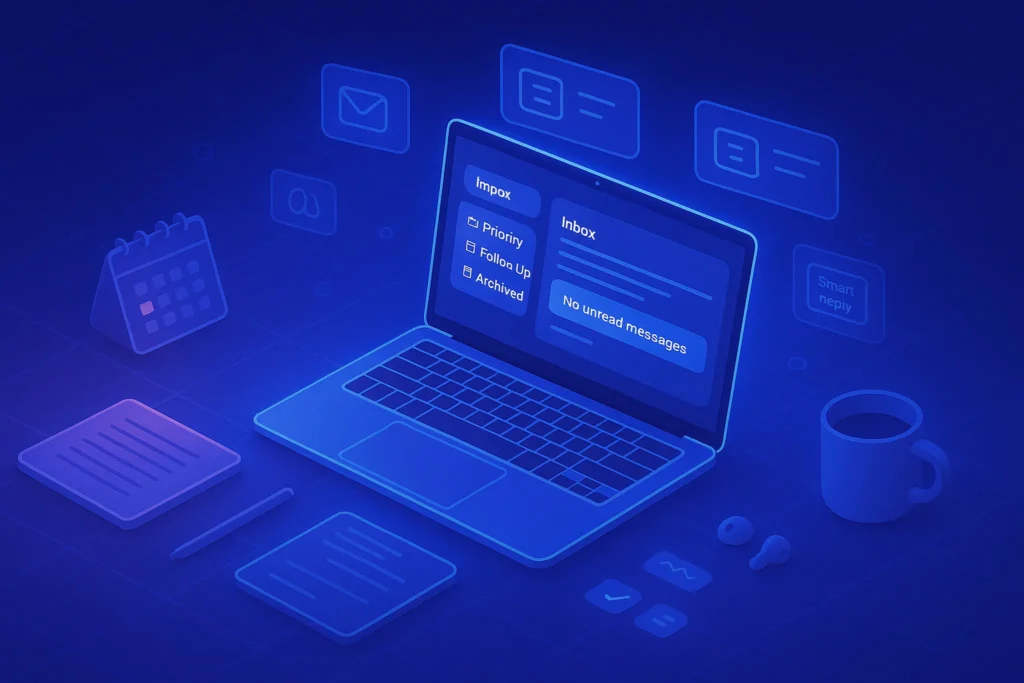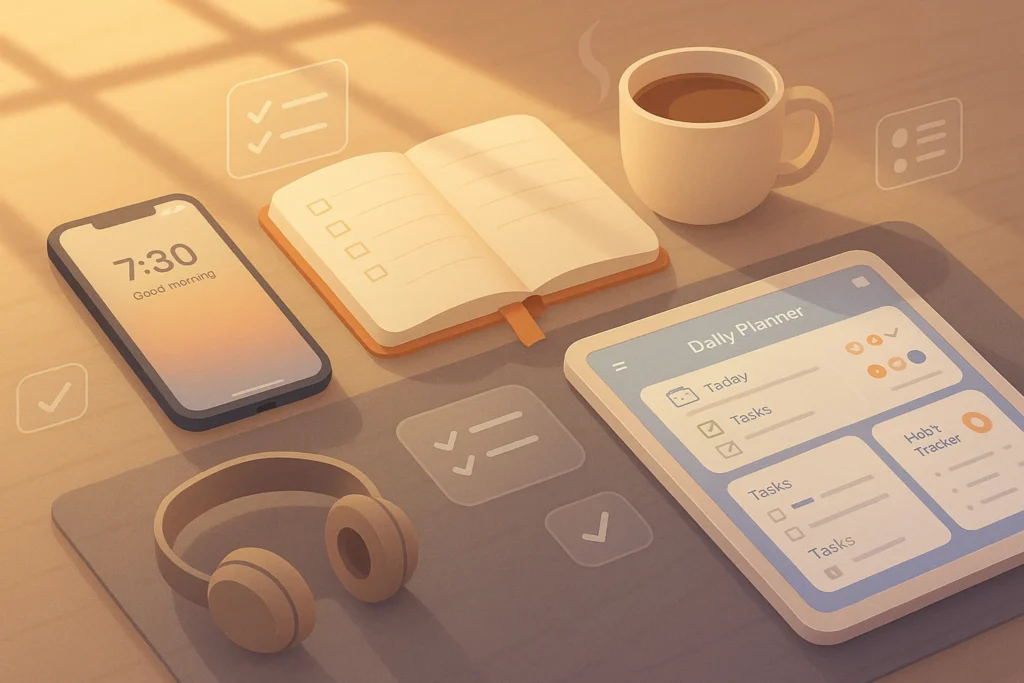📬 Introduction: Email Overload Is Real
If you’re a modern knowledge worker, creator, or entrepreneur, you know the silent productivity killer: a bloated inbox. Between endless notifications, promotional clutter, and overlooked follow-ups, email management isn’t just a minor annoyance—it’s a daily drain on focus and time.
But here’s the good news: email doesn’t have to be chaos. With the right strategies, tools, and mindset, you can transform your inbox from a reactive black hole into a smart productivity hub.
This guide walks you through advanced email tactics used by high-performers—from smart foldering and filters to email block scheduling and powerful third-party apps like Superhuman and Clean Email.
✉️ Smart Foldering, Labels & Filters: Let Automation Do the Sorting
Your inbox shouldn’t be your to-do list. Start by creating a filtering system based on how you want to process emails:
-
Labels and Categories: Separate emails by function—e.g., Finance, Clients, Newsletters, To-Dos. In Gmail, labels + stars create a visually organized flow.
-
Rules & Filters: Automate routing for specific senders (like invoices to “Finance”) or auto-archive newsletters.
Tools like Clean Email even bulk-manage based on behavior—helping you mass-delete or archive based on sender, age, or category.
👉 Already overwhelmed? Our Advanced Gmail Tricks show you how to build these filters without any tech skills.
⌨️ Mastering Keyboard Shortcuts (Yes, They Matter)
Every second counts—especially when you’re triaging emails at scale. Most modern clients support keyboard shortcuts:
-
Gmail:
eto archive,rto reply,j/kto navigate -
Outlook:
Ctrl + Rfor reply,Alt + Sto send
Apps like Superhuman take this even further, with fully customizable shortcuts and muscle-memory-based workflows. Users report cutting email time by up to 40%.
Nerd Tip: Print or bookmark a shortcut cheat sheet for your email client. One week of practice = a lifetime of saved time.
✅ Mastering keyboard shortcuts in Gmail or Outlook can dramatically speed up your daily email routines.
⏱ Schedule Email Blocks—Not Constant Checking
Every time you check your inbox reactively, you’re switching cognitive gears. It takes 23 minutes on average to refocus after an interruption (source: UC Irvine).
Instead, block out 2–3 fixed email windows per day—e.g., 10 AM, 2 PM, and 5 PM.
Pair this habit with tools like:
-
Inbox Pause (Boomerang): Temporarily stop new emails from arriving
-
Focus Assist (Windows) or Do Not Disturb: Silence notifications while you work
If you’ve ever struggled with this habit, our post on Time Blocking vs Task Batching breaks it down.
💤 Snooze, Reminders & Follow-Ups: Outsource Your Memory
Modern inboxes offer built-in tools to delay, remind, and follow up:
-
Snooze Emails: Gmail, Outlook, and Spark allow you to “snooze” an email until you’re ready to deal with it
-
Follow-Up Nudges: Tools like FollowUp.cc or Superhuman nudge you if you haven’t received a reply
-
Calendar Integration: Connect with tools like Reclaim.ai to turn emails into calendar items
This isn’t laziness. It’s cognitive offloading—freeing up your brain to focus on creative, deep work.
📧 Ready to Upgrade Your Email Game?
Try Superhuman or Clean Email and experience the future of inbox productivity. Whether you need lightning-fast shortcuts or intelligent email decluttering, these tools are designed for serious pros.
📦 Email Templates & Auto-Replies: Scale Without Sounding Robotic
If you find yourself rewriting the same message—client onboarding, meeting scheduling, follow-ups—you’re wasting time.
Instead:
-
Create email templates (available in Gmail, Superhuman, Spark)
-
Use tools like TextExpander or Gmail Canned Responses to autofill common text snippets
-
Write polished auto-replies for travel, waitlists, or FAQs
Nerd Tip: Customize auto-replies to include helpful links, like your booking calendar, lead magnet, or support articles.
📬 Want Smarter Inbox Tips Every Week?
Join our newsletter for expert tips on email productivity, content tools, and time-saving hacks. Designed for creators, solopreneurs, and digital pros.
💡 No spam, ever. Only curated ideas worth reading—once a week.
⚙️ Third-Party Tools That Level Up Your Inbox
Here are some powerful apps to boost your email experience:
-
Superhuman – Ultra-fast, keyboard-first email client used by execs
-
Spark – Collaborative email with smart priorities
-
Clean Email – Mass unsubscribe and inbox cleaner
-
SaneBox – AI email sorting and distraction filtering
-
Boomerang – Email scheduling and follow-up reminders
-
Mailman HQ – Pause email during focus time
Each of these tools can be game-changing depending on your workflow and platform of choice.
💡 Real-World Inbox Workflows from Top Performers
Here’s how different pros handle their inboxes:
-
Startup CEO: Checks email once daily at 11 AM, uses Superhuman snippets, and archives 90% of messages immediately.
-
Freelance Designer: Routes all client feedback into filtered folders, uses a “Reply Later” label, and relies on canned responses.
-
Content Manager: Filters pitch requests with Gmail rules, stars urgent items, and runs a weekly cleanup with Clean Email every Friday.
🔐 Privacy & Security in Email: What to Watch Out For
Even seasoned users forget email is a vulnerable vector for phishing and leaks. Best practices include:
-
Avoid clicking unknown links
-
Use encrypted email providers (e.g. ProtonMail for sensitive data)
-
Enable 2FA in Gmail/Outlook
-
Use strong, unique passwords
-
Avoid connecting unnecessary third-party apps
📊 Inbox Analytics: Track Your Habits
Ever wondered how much time you’re spending on email? Tools like:
-
EmailAnalytics
-
Gmail Meter
…can show your average reply time, busiest hours, and response rates. Use this data to optimize your blocks and improve focus time.
🧰 Bonus Tools You Shouldn’t Miss
-
SaneBox – Filters low-priority emails into a separate folder
-
Mailman HQ – Email delivery pause for deep work
-
Boomerang – Add reminders, schedule sends, and more
-
Flowrite – Generate full replies from short prompts using AI
Each tool offers something different—from automation to cognitive relief.
📩 Want the Full Guide?
Download our free PDF “10 Inbox Habits to Skyrocket Your Productivity in 2025” and start taming your inbox like a pro. Just drop your email below and we’ll send it right to your inbox—no spam, just value.
🔐 We respect your privacy. Unsubscribe anytime.
⚙️ Tools That Level Up Email Management
Here are some third-party tools that can completely reshape how you interact with your inbox:
| Tool | Best For | Why Use It? |
|---|---|---|
| Superhuman | Speed + Keyboard Power Users | Fastest UX, built for professionals |
| Spark Mail | Team Collaboration via Email | Shared drafts, comments, smart inbox |
| Clean Email | Inbox Cleanup & Bulk Actions | AI-powered cleanup for cluttered inboxes |
| Boomerang | Scheduling, Reminders & Pause | Works inside Gmail with intuitive UI |
| Mailman | Email Batching & Control | Delivers emails only at specific times |
Looking for more AI-based email productivity hacks? Don’t miss our post on How AI is Transforming Productivity in 2025.
📊 Free vs Paid Email Tools Comparison
| Tool | Free Version Available? | Key Features (Free) | Premium Features |
|---|---|---|---|
| Spark | ✅ Yes | Smart inbox, email scheduling | Team comments, delegation, premium integrations |
| Superhuman | ❌ No | – | AI triage, blazing fast UI, follow-ups, snippets |
| Clean Email | ✅ Limited Trial | Bulk unsubscribe, inbox cleaning suggestions | Auto-cleaning rules, deeper filters, privacy guard |
| Mailman | ✅ Yes | Email batching, quiet hours | VIP lists, smart delivery filters |
🧠 Nerd Tip: Start with a free tool like Spark or Mailman, and upgrade once you’ve defined your workflow and needs.
💼 Email for Teams: Collaboration Tips
When working in a team—whether you’re managing client outreach, support, or content workflows—a shared inbox strategy can massively reduce email chaos. Tools like Spark for Teams allow multiple collaborators to leave internal comments, assign messages, or draft replies together. This is especially powerful for remote-first teams.
Similarly, Superhuman for Teams offers productivity features like shared snippets, collaborative triage, and response analytics—designed for high-performance sales or ops teams.
✅ Use cases:
-
Content teams: Quickly approve influencer pitches or sponsorship offers.
-
Startups: Collaborate on investor comms or customer feedback.
-
Agencies: Manage multiple clients in a single dashboard without chaos.
🧠 Nerd Verdict
Mastering your inbox isn’t just about software tricks—it’s about intentional digital boundaries. With smart automation, scheduled focus blocks, and the right tools, email becomes less of a burden and more of a strategic tool.
If your inbox feels like a battlefield, take a step back, implement just two of the tactics above—and you’ll feel the shift in clarity, control, and cognitive space.
❓ FAQ: Nerds Ask, We Answer
💬 Would You Bite?
What’s your biggest challenge with email: organization, volume, or follow-ups?
Drop a comment or reply—we might feature your scenario in our upcoming Productivity Lab series. 💬



